James Quinn
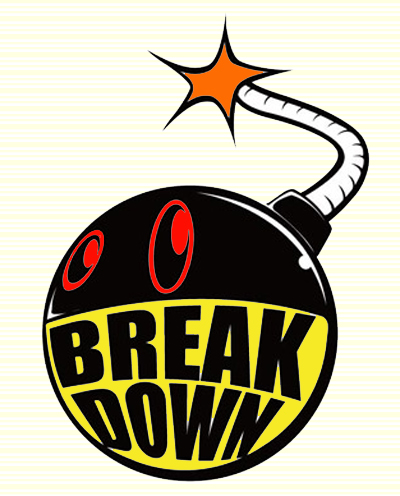
As crooked politicians, Federal Reserve hacks, and cheerleading media pundits inform you the recession is over, you probably have a sneaking suspicion they are lying.
The National Bureau of Economic Research is the arbiter of business cycle recessions. They define a recession as "a significant decline in economic activity spread across the economy, lasting more than a few months, normally visible in real GDP, real income, employment, industrial production."
A depression is characterized by its length, and by abnormal increases in unemployment, a decline in the availability of credit, shrinking output and investment, numerous bankruptcies, reduced amounts of trade and commerce, as well as highly volatile relative currency value fluctuations, mostly devaluations. Price deflation, financial crisis, and bank failures are also common elements of a depression. Let's assess where the U.S. economy stands at the moment:
Economic Factor | Peak to Trough So Far |
Real GDP Decrease | 3.7% real decline from December 2007 until June 2009 totaling $500 billion |
Personal Income | Personal income declined by $339 billion from mid-2008 to the 1st Qtr of 2009 |
Investment | Fixed investment has declined by $543 billion, or 24%, since December 2007 |
Unemployment | There are 8.1 million less people employed today than in 2007 |
Industrial Production | Has fallen 12% since 2007 |
Bankruptcies | National bankruptcies have risen from 800,000 in 2007 to 1.4 million in 2009, a 75% increase |
Trade | Exports and imports declined by 22% and 31%, respectively, between July 2008 and June 2009 |
Currency | The USD has fallen 17% in the last year versus a basket of world currencies |
Bank Failures | 140 banks failed in 2009, with 700 banks in danger of failing, according to the FDIC |
A few economic indicators such as GDP and Personal Income have shown minor positive blips in the most recent quarter due to the unprecedented stimulus applied by the government and Federal Reserve. These effects will be short lived as the stimulus wears off and the economy resumes its downward spiral. At this point in the crisis, real GDP has only fallen 3.7%. By contrast, between 1929 and 1930, real GDP declined by 8.6%. And by the end of 1932, real GDP had collapsed by 26.7%.
Remarkably, real GDP then surged by 43% between 1932 and 1937, to a level significantly above the 1929 level. This fact should be kept in mind as politicians crow about a 2.8% increase in GDP between 2nd and 3rd Quarter of 2009 as the end of the crisis.
To date, the Federal Reserve has printed well over a trillion dollars in an attempt to evade a deflationary collapse, including a $700 billion bank bailout and a $787 billion stimulus package. And then there was $3 billion wasted on Cash for Clunkers ($24,000 per vehicle), $28 billion squandered on the $8,500 homebuyer tax credit, and an artificial suppressing of interest rates to 0% with $300 billion of mortgage-backed securities. And all we've gotten is a 2.8% increase in GDP?
Based on government-reported figures, our GDP has not fallen anywhere near the amount it declined during the Great Depression. But if you believe government-reported figures, I have an indoor ski resort in Dubai I'd like to sell you.
The fact is the government has systematically underreported inflation since the early 1980s. By doing so, it has systematically overstated GDP. Economist John Williams presents the true GDP growth in the following chart. As you can see, the U.S. has effectively been in a recession since 2001. Using these figures, it is probable that we are in the midst of a second Great Depression.
In response, the bureaucrats and financial gurus scoff, pointing to unemployment of 25% during the Great Depression versus 10.2% today. Again, the government figures dramatically underestimate unemployment. The true, non-government-manipulated rate according to John Williams is currently 22%.
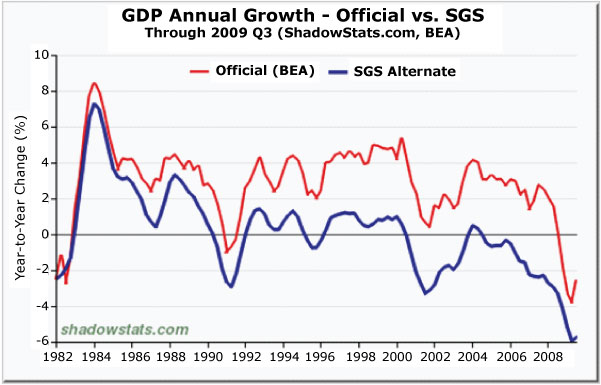
During the Great Depression, there was no FDIC. One-third of all the banks in the United States failed over a five-year period, with 8% of all U.S. banks going under in the first two years alone. In 2009 only 124 banks failed, but bank analyst Chris Whalen from Institutional Analytics predicts that at least 1,000 banks will follow before this crisis is over.
That would be 12% of all the banks in the U.S.
The fact is that the U.S. banking system has seized up, with many banks now deserving the label of "zombie banks." Collectively, these zombie banks have hundreds of billions in toxic assets sitting on their balance sheets. Bankers know there is an avalanche of Option ARM and Alt-A loans that will reset in the next three years, setting off another bout of foreclosures. Bankers know commercial real estate is crumbling. Bankers know credit card and auto loan debt defaults are soaring. They will not lend in this unforgiving environment. The worst lies ahead for the banks.
Based on truthful economic figures, the current downturn is unmistakably not a normal cyclical recession caused by an overheating economy. Based on an accurate assessment of economic statistics, it appears that we are in the early stages of a second Great Depression. And it could be much worse than the first.
The economy bottomed in 1932 and proceeded to accelerate at a tremendous rate over the next five years. There is absolutely no likelihood for a strong economic recovery today. The structural problems fashioned by ignorant politicians and the Federal Reserve over decades have gathered into a perfect storm that threatens the crumbling, fragile levees that are keeping this country from economic collapse.
The Federal Reserve policies since its inception in 1913 have resulted in a 95% decline in the purchasing power of the U.S. dollar. The last 5% will be more traumatic and violent than the first 95%. The dollar has declined by 17% versus a basket of other fiat currencies just in the last year. The Obama administration and Ben Bernanke have blessed the dollar decline. But by doing so, they are playing Russian roulette with the U.S. financial system.
The Federal Reserve has set short-term interest rates at 0%. Inflation has been running at a 4% annual rate over the last four months, so real interest rates are a negative 4%. This is certainly one major factor in the dramatic decline of the dollar. The foreign countries that hold U.S. Treasuries know they are getting screwed. On a short-term basis, they have no choice but to hold these Treasuries. But on a medium- and long-term basis, China, India, Japan, and the Middle Eastern countries are exiting their USD positions.
The percentage of foreign reserves held in dollars has declined from 56% in 2000 to 41% today. China is using its dollars to buy natural resources across the globe. India used its dollars to buy $200 billion of gold from the IMF two weeks ago. The implications of our foreign creditors not trusting our fiscal policies will have dire consequences.
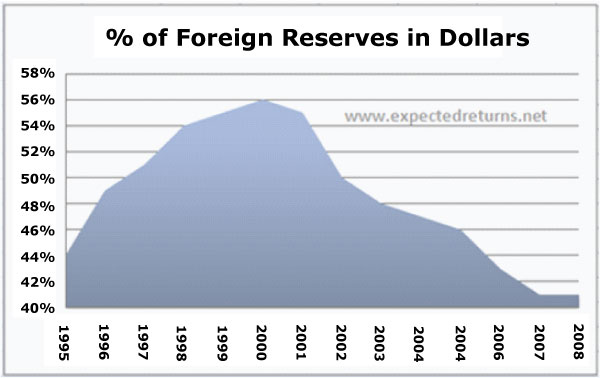
Peter Bernholz, professor of economics at the University of Basel, Switzerland, in his most recent book, Monetary Regimes and Inflation: History, Economic and Political Relationships, analyzes the 12 largest episodes of hyperinflations - all of which were caused by financing huge public budget deficits through money creation.
His conclusion is that the tipping point for hyperinflation occurs when the government's deficits exceed 40% of its expenditures. The deficits being run by the Keynesians in Washington are now at that level, well beyond anything ever attempted in U.S. history. Our leaders have chosen to allow insolvent banks to keep toxic assets on their books at inflated prices, propped up bankrupt union-controlled automakers, instructed Fannie Mae, Freddie Mac, and GMAC to make loans that will never be repaid, and squandered $787 billion on payoffs to congressmen through pork projects that have stimulated nothing.
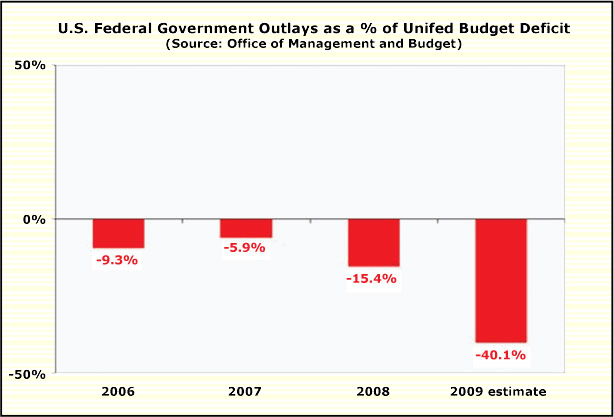
With unemployment of 10.2% and headed higher, the Federal Reserve has absolutely no intention of raising interest rates. President Obama and Timothy Geithner can do a hundred interviews declaring that reducing deficits is a huge priority, but their actions speak louder than their lying words. The national debt increased by $1.8 trillion in 2009, to $11.9 trillion. The OMB projects the 2010 deficit to reach $1.5 trillion. Even without a new colossal $2 trillion healthcare bureaucracy, deficits were expected to stay in the $1-trillion-per-year range for the next decade. The truth is that deficits will exceed $1 trillion annually and approach $2 trillion by 2019. The national debt would reach $25 trillion by 2019.
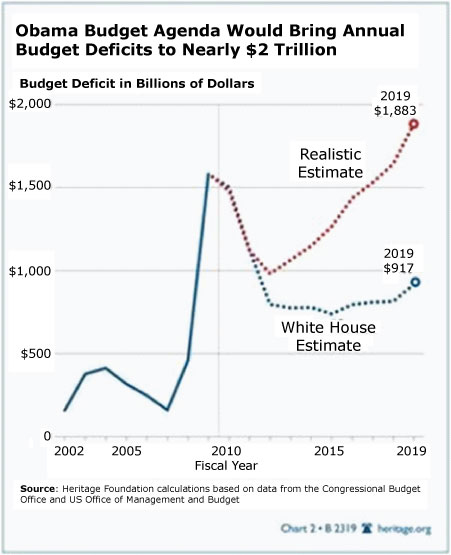
An unsustainable trend will not be sustained. The national debt will not reach $25 trillion in 2019. Unless the current policies of the Federal Reserve and Obama administration are reversed, the U.S. economic system will collapse well before that. In a recent report, Société Générale, one of France's biggest banks, noted the possibility for collapse:
"As yet, nobody can say with any certainty whether we have in fact escaped the prospect of a global economic collapse. The underlying debt burden is greater than it was after the Second World War, when nominal levels looked similar. Aging populations will make it harder to erode debt through growth. High public debt looks entirely unsustainable in the long run. We have almost reached a point of no return for government debt. "
There is no foreign country willing to buy the $13 trillion of debt paying 1% we will need to issue in the next ten years. Obama and Congress are working on another stimulus program, clearly indicating that they are going to continue their efforts to spend the country out of crisis.
Trust in the American financial system and its leaders is dissipating rapidly. At some point in the not-too-distant future, the U.S. Treasury will attempt to sell debt and foreign buyers will boycott the auction. That will mark the point of no return. The unprecedented levels of debt propping up the American Empire cannot withstand higher interest rates. When it collapses under the weight of its massive debt, the dollar will crash and hyperinflation will result. People need to prepare for a future of turmoil and uncertainty. From an investment perspective, gold will retain its value as the dollar falls. Shorting U.S. Treasuries will ultimately prove to be a great investment.
© 2010 James Quinn Bio: James Quinn is a senior director of strategic planning for a major university. These articles reflect the personal views of James Quinn. They do not necessarily represent the views of his employer and are not sponsored or endorsed by his employer. He can be reached at quinnadvisors@comcast.net.
James Quinn (215) 573-5404 Phone | Email
theburningplatform.com
Nessun commento:
Posta un commento